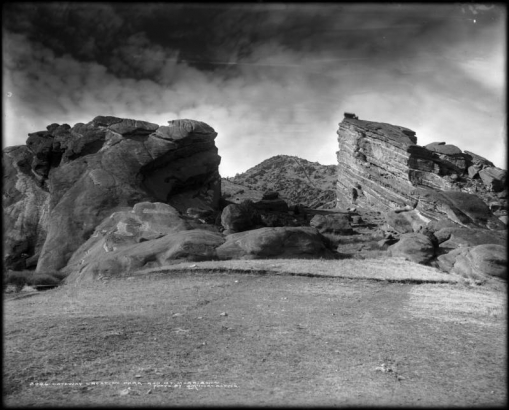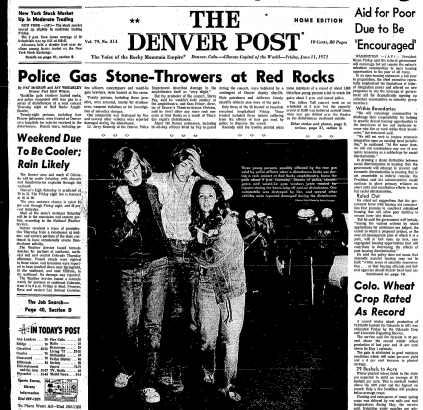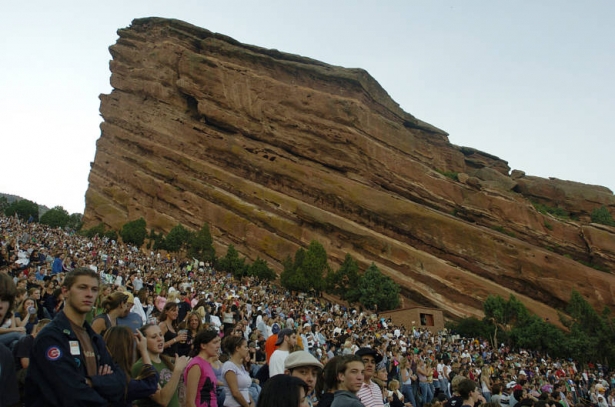On June 10, 1971, a large group of rock fans attempted to bum-rush the gates at Red Rocks Amphitheatre in an effort to see the band Jethro Tull.
In the aftermath of that event, the City of Denver imposed a ban on all "rock" shows at the venue, which didn't turn out quite how the City (mainly Mayor Bill McNichols) planned.
In fact, the city's rock ban actually wound up spurring on one of the most successful concert series of all time and catapulted Red Rocks into the realm of concert venue legend.
They Came from the Hills
If you're having trouble imagining how a Jethro Tull concert could turn into a riot, it might be a case of, "You had to be there to understand." In the late 1960s and early 1970s, plenty of young people felt as though music was an entity that shouldn't be commercialized. They were also not above using the full force of youth to rush into concerts, as was evidenced at the legendary Woodstock Festival.
That dynamic was in full effect at Red Rocks that night when thousands of fans who hadn't purchased tickets congregated in the hills surrounding Red Rocks to catch a free listen to the long sold-out show. The trouble began when the "hill people" decided that they should just go ahead and force their way into the amphitheater.
This did not go down well with the Denver Police Department, who have long held jurisdiction at Red Rocks on concert days.
What happened next was recounted by Chris Van Ness in the June 18, 1971, edition of the Los Angeles Free Press:
The police, feeling that it would be impossible to maintain security in any other way due to the rough terrain, began dropping tear gas out of helicopters which were flying a dangerously low watch over the crowds.
Rather than acting as a deterrent, the tear gas seemed to spur the now-rioters on to further acts of violence As more tear gas began to fill the amphitheater at an alarming rate, the gate-crashers and audience alike began to pick up bottles and rocks to use as ammunition against the police. One car was overturned and burned, and many people suffered injuries ranging from broken bones to gas inhalation.
Not only did the tear gas not quell the riots, it made its way to the stage at the base of the natural amphitheater. The scene could only be described as bedlam, and it had the potential to be a lot worse.
Welcome to World War 3
Backstage at Red Rocks, Barry Fey and the members of Jethro Tull were faced with a conundrum. They could cancel the show and send the paid audience straight into a riot, or they could play the show as planned.
To their everlasting credit, the members of Jethro Tull decided to go on with the show. Jethro Tull lead singer Ian Anderson took to the stage with guitar in hand and greeted the audience saying, "Welcome to World War Three!" And with a full-scale riot playing out in the hills surrounding them, and clouds of tear gas wafting onto the stage, Jethro Tull proceeded to play their full set.
The band's commitment to playing on earned them praise from both the Denver Police Department and Fey, who praised the band in the Los Angeles Free Press saying, "God bless those guys. They're the most professional group I've ever worked with. I don't know anybody else that would have stayed on through all that."
Rock 'n' Roll Aftermath
Reaction to the events at Red Rocks that night came swiftly from Denver Mayor Bill McNichols. The very next day, the mayor swiftly imposed a ban on all rock shows at Red Rocks saying:
As long as I'm mayor, this city is not going to be turned over to rock-throwing hoodlums. If they think they're going to be allowed to run free, attacking innocent people and police officers, they have another guess coming.
McNichols was hardly alone in his view on the future of rock 'n' roll at Red Rocks. Caught up in the moment, a clearly frustrated Fey said that he was done promoting rock shows at Red Rocks. In an interview with the Denver Post on June 11, he said, "If they (the rock artists) want to come into the (Denver) Coliseum (instead of Red Rocks), we'll do it. But most of them know of Red Rocks and wanted to play there."
Though Fey would ultimately change his tune regarding Red Rocks, Sam Feiner, the director of the city Theatres-Arenas Division, was firm in his stance that Red Rocks's time as a rock venue had, "definitely ended." To that end, upcoming shows by hard rock heroes Poco, Chicago, and Stephen Stills were canceled.
The Blame Game
In the aftermath of the riot, there was plenty of blame to go around. While the Denver Police were accused of overreacting to the situation by dropping tear gas, most of the blame was rightly aimed at the gate-crashing rioters.
At the Los Angeles Free Press, Van Ness said, "When it comes to placing blame for the events of last Thursday evening, it must rest with the kids who tried to crash the gate. But the rest of the chemistry is an all-too-familiar formula. The police reacted with fear and stupidity."
At the Rocky Mountain News, music critic Thomas MacCluskey pulled no punches in a column titled, "Rock Rowdies Ruin it for Everyone." MacCluskey pointed out that this was hardly the first time that Denver music fans had acted up.
He recalled that in August 1968, a riot had broken out at an Aretha Franklin show at Red Rocks after the legendary performer told the crowd that she would not be playing because she hadn't been paid. That resulted in a one-year ban on rock shows.
MacCluskey used that as a jumping-off point to school an entire generation for its entitled behavior. "Yes, you 'get-something-for-nothing' generation—in fact, 'get-everything-for-nothing' fools—you caused a one-year ban on rock concerts then...You're just too cute for words."
The angry critic went on to predict that there wouldn't be any rock shows at Red Rocks, "...until your little brothers and sisters come along and realize that what you're trying to do is an utter impossibility. There is no 'something-for-nothing' in this universe."
MacCluskey was right, for a few years anyway.
Barry Fey vs. The Man
Mayor McNichols was not kidding when he said that rock shows at Red Rocks were a non-starter, as the 1972 Red Rocks schedule neatly illustrates. That summer's lineup did not rock, even a little bit. Artists on the bill that year included Joan Baez, Pat Boone and the Carpenters.
And that's the way it was, right up until Fey took the City to court and won the right to once again book rock acts at Red Rocks. With a dash of typical Fey flair and marketing finesse, the legendary promoter christened the now-familiar, "Summer of Stars" series in 1976.
The Bicentennial summer's lineup was considerably more dynamic than it had been in 1971-1975. Acts on the bill included Neil Young, Stephen Stills, David Crosby, Willie Nelson and the Average White Band. (Remember to view these bands through the lens of 1976, when acts like this represented mainstream rock 'n' roll and were considered to be somewhat anti-establishment.)
That summer launched Red Rocks into the stratosphere and as the Summer of Stars established itself, Red Rocks became America's premiere outdoor music venue.
Red Rocks Forever
From U2's iconic "Under a Blood Red Sky" performance in 1983 to dozens of sold-out nights with the Grateful Dead, and a list of artists that's too long to mention (but is conveniently listed on the Red Rocks' Concert Archive), Red Rocks has offered something for everyone.
What's more, an evening at Red Rocks is always tinged with Colorado's natural beauty—the twinkling city lights serving as an almost magical backdrop to the music coming from the stage.
Red Rocks is also a favorite spot for artists and plenty of aspiring artists have it on their bucket lists.
The memorable amphitheater is so far ahead of the curve that Pollstar Magazine, a trade journal for the concert industry, awarded Red Rocks it's Best Outdoor Venue Award 11 years in a row. To give other outdoor venues a chance, Pollstar went ahead and changed the name of the accolade to the Red Rocks Award in 2001 and took Red Rocks out of the running entirely.
Of course, anyone who has ever attended a show (or graduation or church service or film) at Red Rocks knows what a special place it is and how much it means to the people of Denver. And while there have been plenty of rock shows at Red Rocks since the ban was lifted, there hasn't been anything quite like the night Jethro Tull fans almost ruined Red Rocks for everyone.
What's your favorite Red Rocks memory? Share it in the comments section below or on the Western History & Genealogy Facebook Page.





Comments
i was there running up the
i was there running up the hill cops on horses.great time.
Thanks for sharing your
Thanks for sharing your memories (and glad you made out in one piece!).
I was also there in the crowd
I was also there in the crowd on the hill behind the amphitheater. Most people were sitting to milling about when someone further up the hill with a trumpet blew the traditional "charge" anthem, and the crowd began to move down the hill towards the amphitheater. Police on horseback could not hold so helicopters began dropping teargas to disperse the crowd. We eventually did get inside the amphitheater just as Ian Anderson came on stage. "Welcome to World War 3!"
Hi Spiff! Thanks for sharing
Hi Spiff! Thanks for sharing that memory with us. It's really interesting to hear lots of different perspectives on the show that help us build a really broad picture of the event!
Does anyone remember a Moody
Does anyone remember a Moody Blues concert there in the early 70s? I am positive I went to one then but I can't find any mention of the concert.
Yes, I was there at the July
Yes, I was there at the July 10 1971 Jethro Tull Rock concert, sitting at the top of the hill, just west of the stage, a perfect view,(with high powered glasses). We had a perfect view of every thing. We watched rockers build up at the west end of the seating area and win 3 or 4 gathered together they would hop the rails an run thru, there being only 2 or 3 policemen there the police could only catch one, next thing this procedure caught on and before you know it there were dozen's of rockers hopping the rails, then we seen the police busses coming up the roads, reinforcements arrived with more patrol cars helicopters horses they closed all the gates, let the dogs out! people getting out of there cars were being attacked by police dogs (big Dobermans), people with tickets were shot with rubber bullets We could see them waving there tickets as they are being shot at and being pursed by dogs meanwhile tear gas is every where from the helicopters from guns, one tear gas grenade bounced off a railing and rolled underneath a cruiser and the car went KAWUMP!! and rolled on its side, a horsemen went over the fence (which is the end of Denver and beginning of private property), and came up the rocks towards our position, a tear gas grenade went off by the horses feet and it stumbled, horseman and horse went tumbling back down the rocky slope, Ian Anderson raised his flute and said " this thing's hard enough to play, all this gas has put an end to it" and that was it. the concert was over.
Hi Sam - Thanks for that
Hi Sam - Thanks for that firsthand account. It's always interesting to hear the perspective of events like this from various angles and yours was an angle that was right in the thick of it!
I was inside this concert. My
I was inside this concert. My friends were on the hill behind the seating.
The story must not have talked to anyone that was there.
Inside we watched as the Police helicopter flew over and drop a teargas canister in the Dead center of the crowd. The timing of the drop would not have been possible to miss the crowd.
We had to go under cover of our sleeping bags and hope the wind would clear it.
My friends on the hill outside said a police officer on a horse had a German Shepherd that he allowed to attack this Man for no reason they could see. The dog was not being stopped by the officer on his horse so the other people started to throw rocks at the dog. Then they escilated to what happened. I wish I had a cellphones to document the police bad behavior to kids having fun
Hi Katherine - Thanks for the
Hi Katherine - Thanks for the first hand account. Primary sources, like your story, are the gold standard for historians. For this blog, we relied on published accounts which, not surprisingly, are frequently different from what eyewitnesses report and remember. And, yes, many historical events would likely have been reported very differently if cellphones had been around.
Thanks for reading and commenting!
I WAS ALSO THERE.FROM MY VIEW
I WAS ALSO THERE.FROM MY VIEW AT THE FRONT I WILL NEVER FORGET A BLOND GIRL FAR AWAY FROM ANYONE MINDING HER OWN BUSINESS, DANCING TO THE MUSIC A COP ON HORSEBACK LET HIS GERMANSHEPERD DOG LOOSE AND RIP A BIG HOLE IN HER LEG .FROM MY VIEW THATS WHAT STARTED THE RIOT. IF ANYONE KNOWS WHAT HAPPENED TO THE GIRL OR WHO SHE WAS,ID LIKE TO NO GLENN.SVANES@GMAIL.COM
Add new comment